#improved hull performance
Text
0 notes
Text
It's no wonder Out happened when you really think about it. Nastya doesn't like organic life because it's complicated, it can break, sometimes it's even unfixable.

quote from gender rebels
Nastya is in love with Aurora, and in saying that she is saying "you are not organic life, I can deal with you because you are metal and algorithm and predictable" - we can see this in bedtime story when she says she'll tweak Aurora's story creation algorithm

screenshot from A Bedtime Story
Aurora is not inorganic. She is not ai. She is a space moon made of flesh and blood and teeth and bone. She is not an ai. She is a body that was taken and stripped of autonomy, of the right to self identify, of the right to think- to be imperfect and organic.
The metal is a veneer that hides how messy and traumatized and unfixable she is. From the outside she is a starship. From the inside she can still bleed.
And this makes them fundamentally incompatible. But yet, they are in love.
And really, it's no wonder Nastya fell in love with Aurora. Let's take a look at Nastya's home planet, or at least home society:
"Terminals were scattered across the planet. There was one on every street corner, one beneath every lamppost and one in every commune block."
"The midwife-machine performs a series of programmed manœuvres to quieten [the baby]. It cradles it and hums at several pitches until it finds one that seems most soothing. Mechanical arms stroke the baby’s flesh even as others start the process of implanting augmented reality interfaces into its nervous system."
"The Czar an atrophied frame, never present in the real world and worn to dust by the chemical compounds that kept his brain alive so it could live forever in a perfect virtual paradise. The Rabotnik a copy, a mind preserved unchanging in the instant before its death and placed in an everlasting metal frame."
(Cyberian Demons)
Its safe to say the world Nastya was born into, from the very minute she was born, was ridden with technology. She has augmented reality interfaces inplanted into her from birth. It would stand to reason that being taken from this society, wherein technology is everywhere, inside and out, would stand for a bit of a shock.
Aurora too had been augmented by the Cyberia.
While it is stated that the last time Nastya had used the ports themselves was directly before her death — "The last time she had used the ports, her tutor had ripped them out of her as the rebels stormed the palace" — Aurora is laced with Cyberian technology. I'd imagine she has something of a 'bluetooth wireless connection' with Aurora, rather than the physical data transfer of files between the ports and Nastya, it may as well be similar enough.
Imagine being Nastya, going from Cyberia, wherein there is augmented reality contantly, transplanted onto a ship with metal blood, a jonny, and a vampire. To Aurora, where the only bits of augmented reality run through Aurora.
Of course she'd fall in love with her. Aurora is familiarity. Aurora isn't organic. Aurora isn't human.
And of course when the undeniable part of aurora that is organic, that is a flesh moon plated in metal with her brain hooked to machines, when so much has broken and been replaced, when, presumably, aurora is less of an algorithm, nastya leaves with the brand cyberia left on her.
Because Aurora healing, becoming more of herself and less of a starship, is messy, and organic, and human.
and hard for nastya.
‘Think how long she’s been flying you around. Think how many bullet holes you’ve punched through her and how many atmospheres you’ve dropped her through. Think how many alterations and improvements we’ve made, Tim to her guns and Ashes to her storage and Brian to her engines and the Toy Soldier to who knows what. How much do you think is left of her after all she’s brought you through?’ Nastya held up the ancient, battered piece of hull plating. Just visible under the grime and scars of particles of space junk was a fragment of the Aurora’s original logo and serial number. Jonny honestly couldn’t remember the last time he had seen a version that hadn’t been painted by the Mechanisms themselves.
‘So she’s free, now.’ Nastya gestured around at the spaceship they were standing in. ‘This Aurora can take you where you want to go. I’m going to take my Aurora somewhere else.’
Aurora was ship of theseus'd. Aurora was improved. Aurora was no longer cyberian. (both literally, and metaphorically)
So nastya left.
383 notes
·
View notes
Text
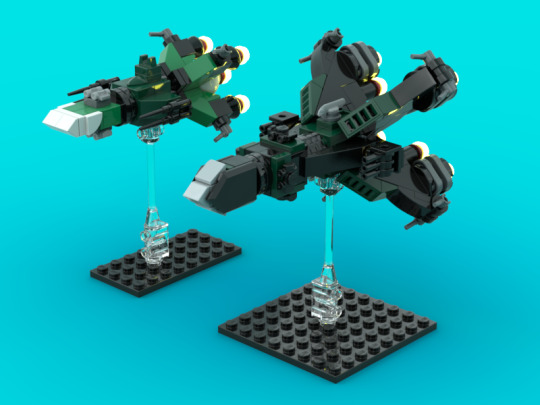
J03 Hunter Class destroyer & F16A Marathon class Heavy Cruiser, scaled for playing Mobile Frame Zero: Intercept Orbit. Inspired by the MCRN Donnager battleship from The Expanse.
---

The J03 Hunter Class destroyer, designed and built by the First Great Expansion megacorp Northern Sky, was a dedicated seek and destroy platform designed to overrun targets with a single minded ferocity. The class often performed picket duties or acted as forward deployed scouts, but it truly shined when it was able to engage in one sided fights, chasing wounded and/or isolated prey, and was known for pack hunting, multi-dimensional pincer attacks that drove a target into a vector for one of the destroyers to ram for a killing blow.
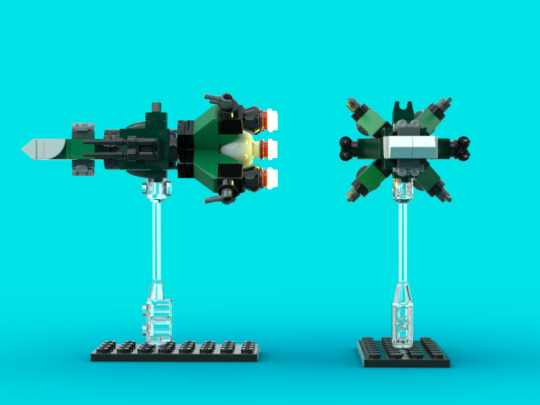

Its primary weapons were two side mounted dual railgun chase armaments, a capable enough system to damage enemy light to mid armor while being relatively easy to maintain. In lieu of thick hull plating which would have slowed the class, a multi-layered defense of PDGs and defensive missile turrets (capable of firing anti-missile missiles as well as chaff/dazzlers) allowed the destroyer to capitalize on its speed for both aggressive as well as defensive maneuvering. The forward section of the class was also heavily reinforced for ramming, and was painted to evoke the grinning maw of an apex predator like aircraft nose art of old.
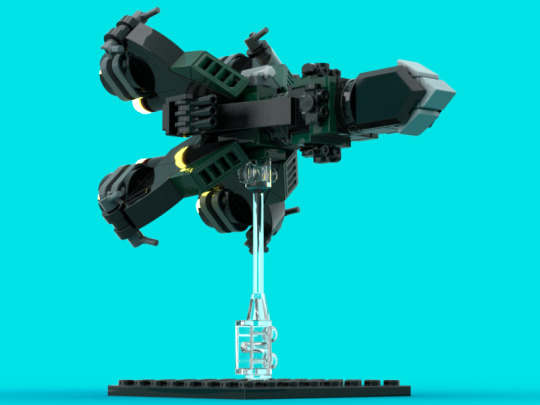
The F16A Marathon class heavy cruiser on the other hand was a dramatic scaling up of the venerable Hunter class, albeit with a much different mission in mind. This heavy cruiser was intended for extended solo operations such as deep space exploration, strategically hidden emergency reinforcements, or advanced system scouting; as such it needed the legs to operate on its own, carrying enough bullets, beans, fuel, and propellant to maintain happy and fully operational battle stations. Its massive armored bulk was supported by no less than eight engines, the primary four of which were over engineered for safety's safe; a catastrophic failure when the ship was millions or billions of miles from the nearest safe harbor or ally was a serious concern. Its primary weapons were two 3-barrel cannon launch missile turrets with exceptional firing arcs, that offered an impressive range of initial firing arcs. By forgoing traditional VLS cells or launch tubes, the Hunter class sacrificed volley mass and refire rate for exceptional accuracy and engagement ranges. The Marathon also mounted the same model PDGs and defensive missile turrets the Hunter class did, though with double the number of both included (later 'B' and 'C' variants instead tripled the number of missile turrets as instability throughout human and Ijad space began leading to large scale space fleet combat).
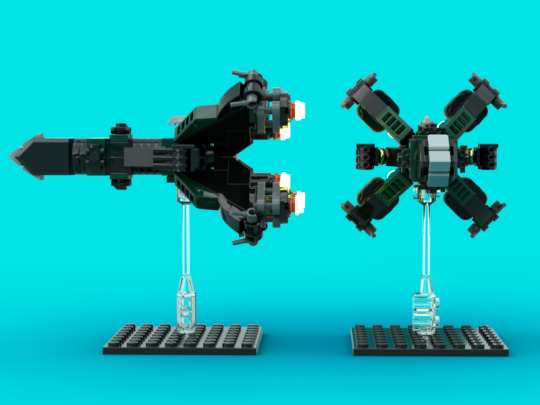

A Marathon could also easily have served as a flagship for a military or megacorp fleet, although the newer 'B' (improved C&C facilities and outsized comms arrays) and 'C' (mobile frame hangar and catapult) hulls were better suited for modern mobile frame centric combat. Despite its age, the original Marathons were still powerful forces to be reckon with, should an organization have had the resources and manning to support one. Unfortunately, as space combat transitioned from one-sided curb stomp beatdowns between well funded militaries and upstart colonists with more bravado than brains (not to mention the occasional megacorp skirmish over resources) to full on interspecies warfare between the human goverments and the Ijad forces with Free Colony Cells not only popping up more frequently every day, but also increasingly better trained and better geared, the heavy cruiser saw the end of its heyday. While the purpose built combat ship was ton for ton superior to most converted civilian vessels used by free colonists, as well as the oddly alien designs the Ijad introduced, the increase of space based mobile frame companies closed the gap enough that many militaries decided that the class just wasn't worth the manning and logistics to field any longer, in favor of smaller, more modern light cruisers, battle cruisers, and carriers that came to dominate The Second Great Expansion.
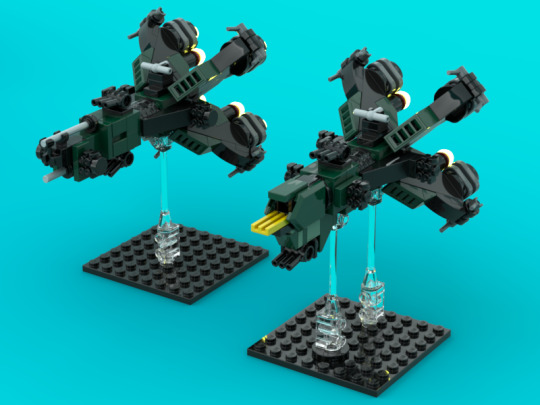
68 notes
·
View notes
Text
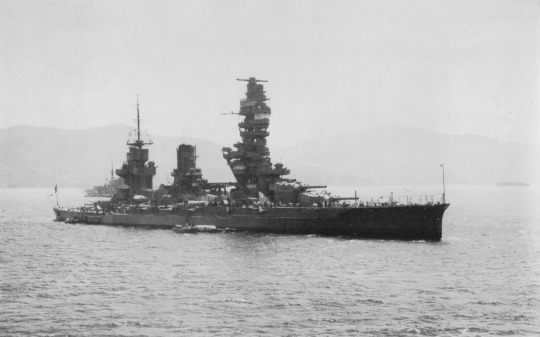
The Japanese battleship Fusō with her pagoda mast following her 1930s modernization. Many people are familiar with the pagoda masts themselves, but are less knowledgeable about the purpose of these imposing structures.
The pagoda mast was a lesson in function over form. It was a bid to improve the overall performance of the battleship in combat with the technology available at the time.
Japan began to equip its warships with more spotting devices, rangefinders, directors, search lights, and other equipment. All of this equipment required platforms to carry them and permit their operation. These platforms had to be spaced out to keep the equipment from interfering with each other in operation. This extensive layering of the platforms on the forward tower resembled the distinctive appearance of a pagoda tower, leading to the nickname. The extensive towers were also useful in that they provided extensive shelter to the crew in this part of the ship, allowing them to better perform their duties in inclement weather.
These towers were also quite large. Depending on the battleship, the towers soar over 30m (100') over the waterline. Despite the large size, they did not impact stability as much as one might think. Japanese designs conducted extensive calculations on the top weight of the pagoda towers and balanced them out by increasing the beam of the battleships during modernization through the addition of bulges. The ships remained relatively stable even after the addition of Pagoda towers. For instance, the Ise class saw their metacentric height increase from 1.74m (5.9') just after their completion to 2.81m (9.3') after their 1930s modification. The biggest change was the additional weight and beamier hull made their rolling motion shorter and faster whereas they originally had a longer, slower rolling motion.
The Japanese pagoda masts were contemporaries to the British "Queen Anne's Mansions" superstructure design found on their battleships of the same period. These towers evolved to fulfil a similar function (though the British ships typically were smaller and featured greater enclosed spaces) and, like the Japanese pagoda towers, were used to improve older designs.
It's worth pointing out that the impressive tower structures of the Yamato class battleships were derivatives of the pagoda masts. Like earlier designs, they feature extensive platforms for rangefinders, observation gear, and other equipment. The biggest difference was that the towers of the Yamato class were more streamlined to allow them to better avoid the effects of muzzle blast from the battleship's massive 46cm (18.1") guns.
17 notes
·
View notes
Text
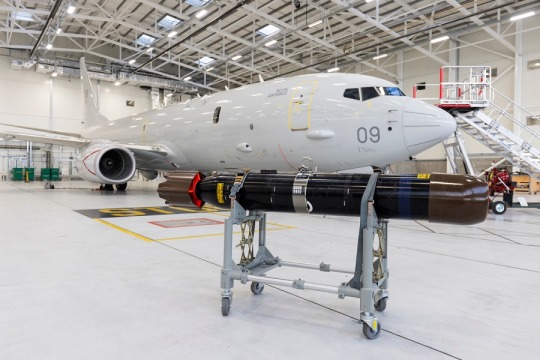
RAF chooses UK-made Sting Ray torpedo for its Poseidon fleet
Fernando Valduga By Fernando Valduga 12/02/2023 - 15:00 In Armaments, Military
The United Kingdom Ministry of Defense chose the British-made Sting Ray torpedo as its future torpedo capability, along with the continued use of the U.S. Navy's Mk54 weapon in the RAF's Poseidon maritime patrol aircraft.
The program to integrate the Sting Ray Mod 1 with Poseidon is underway and will give the United Kingdom a powerful and sovereign torpedo capability, providing flexibility to the Poseidon fleet.
In service in the Royal Navy, the Sting Ray Mod 1 is capable of integration into aerial and surface platform mission systems. The Sting Ray Mod 1 is a light anti-submarine war torpedo launched from the air, launched from frigates, helicopters and maritime patrol aircraft against submarine targets of all kinds.
It has a sophisticated acoustic return system and a high-precision navigation system. The torpedo can detect, classify and attack targets autonomously. It has low costs over its useful life and does not require intrusive maintenance throughout its useful life.
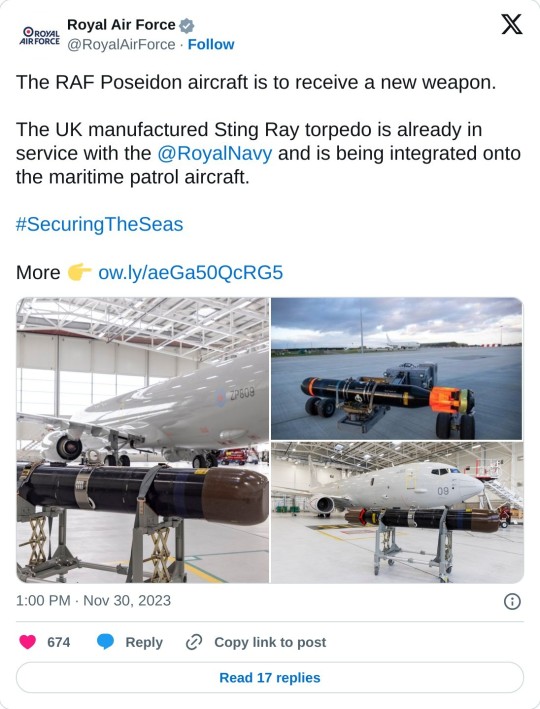
Taking advantage of the investment in the original Mod 0 variant of the torpedo and its support infrastructure, the improved Mod 1 weapon sustains the position of the Sting Ray as the world's leading light and autonomous underwater weapon in the coming decades.
The Sting Ray Mod 1 is designed to defeat the double threats of fast and deep double-hull submarines operating in the ocean environment and the silent and conventional submarine in coastal waters. The improved performance of Sting Ray Mod 1 is supported by the development of a new acoustic and tactical software, taking advantage of the knowledge acquired in extensive water tests with the Mod 0 weapon.
The RAF P-8 Poseidon is a multifunctional maritime patrol aircraft, equipped with sensors and weapon systems for anti-submarine and surface warfare, as well as surveillance and search and rescue missions.
Tags: weaponsMilitary AviationP-8A PoseidonRAF - Royal Air Force/Royal Air Force
Sharing
tweet
Fernando Valduga
Fernando Valduga
Aviation photographer and pilot since 1992, has participated in several events and air operations, such as Cruzex, AirVenture, Dayton Airshow and FIDAE. He has work published in specialized aviation magazines in Brazil and abroad. Uses Canon equipment during his photographic work in the world of aviation.
Related news
MILITARY
To combat laser weapons, USAF improves pilots' eye protection
02/12/2023 - 13:00
Turkish Aerospace Industries developed the Anka-3 unmanned aerial combat vehicle to operate alongside its new national KAAN fighter. Anka will make its first flight in mid-December, while the first KAAN flight is scheduled for December 27.
MILITARY
Turkey prepares the first flights of the ANKA-3 drone and KAAN poaching for this month
02/12/2023 - 12:00
MILITARY
Russia destroys Ukrainian Su-25 jet and then discovers that it attacked a model used as bait
02/12/2023 - 09:00
MILITARY
Venezuelan military aircraft present painting clamoring for the Essequibo region
01/12/2023 - 23:15
MILITARY
Czechs have already raised 500,000 euros to offer Black Hawk helicopter to Ukrainian intelligence
01/12/2023 - 21:46
The new helicopters delivered to the Indonesian military.
HELICOPTERS
Indonesia receives eight new Airbus H225M helicopters assembled in the country
01/12/2023 - 18:30
10 notes
·
View notes
Text


A ship model, by anonymous, c. 1760
Such paintings of ship models were part of the construction process of a vessel. These rigorous, technical images were evaluated by the naval authorities and their decision determined whether the vessel would be built. Models and paintings of models allowed experts to detect defects or decide on improvements and also obliged shipbuilders to use the materials specified in the project and to build the vessel as shown. The result was to avoid fraud and modifications to the structure that might make the ship weak and unsafe. From 1649 in Britain it was specified that models had to be made for all ships prior to their construction and be approved by the Admiralty. These models were known in their time as “Admiralty models” while in Spain they were termed “construction or shipyard models”.
As can be seen in the present examples, the model shows part of the hull and its woodwork. This allowed for an examination of details such as the keel, timbers, stem and stern-post and other elements below the water level. Also left visible are part of the decks in which the construction and the interior accommodation could be checked. Such details allowed the relevant authorities to check the resistance and strength of the hull, the ship’s navigability in manoeuvres and its behaviour in combat, all with the intention of ensuring its seaworthiness and performance in order to avoid defects that would prevent it from carrying out its intended function.
72 notes
·
View notes
Note
Why does that old USS Texas have that curved bow? What's the purpose?
I thought bows were pretty straight until bulbous bows came along, but that's years after this
Ah, you mean the inverted bow.

Sometimes called a reverse bow or ram bow, this bow was added to large caliber gun ships of the era for handling and stability.

The basic premise is that it improves the ship's hydrodynamic properties, by reducing drag and increasing performance. It makes the ship longer to improve the beam to width to ratio, which increases it stability. Water flows around a longer, thinner hull much more easily as it produces a lot less drag than a shorter, beamier hull.

"Due to their design, inverted bows also have a finer shape forward, letting them cut through the water easier. As a ship moves through the water, it creates a wave of water at the front of the hull. The larger the ship, the larger the wave. The larger the wave, the more energy it takes to push it. Thus, these bow waves rob power from the ship, adding weight that it must push. An inverted bow can more easily cut through this wave rather than push it along." This means the enemy has a harder time gauging your speed. While also having less of the ship above the water.
Another point to consider, ships of this era had relatively weak engines and less efficient hull forms. The inverted bow was compensation for these deficiency.
The downside was these ships would take on more water in rough weather. The bow tended to cut through or dive down rather than over a wave. Coupled with this, these lower reserves of buoyancy in the bow. In short, they made for less seaworthy.

These were found on all of the US Battleships before the South Carolina Class. They fell out of favor when power plants became more powerful and the US Navy wanted more seaworthy vessels. They were replaced with the bulbous bows and later the Clipper bow. Power plants were bec

Although, they have made somewhat of a comeback with the Zumwalt Class Destroyers, as the lower bow wake increased their stealth abilities.
Thanks for the ask.
Library of Congress: LC-D4-20993
source, source, source, source
NHHC: NH 65755, 19-N-13046, NH 45499
#ask#anon#inverted bow#battleship#predreadnought#dreadnought#warship#ship#united states navy#us navy#navy#usn#u.s. navy#my post
44 notes
·
View notes
Text

Its time to give my headcanon for one of my favorite StarTrek ships, the U.S.S. Yeager
By the dawn of the 2370s, Starfleet was, once again, embroiled in an Arms Race for the survival of both itself and the Federation. It had began the 2360s as the top power in the known Galaxy, its only near peers either allied or hadn't been seen in a *century*. Now the Klingon-Federation Alliance was failing, the Romulans had emerged from their isolation, the Borg had *slaughtered* the Federation Fleet at Wolf 359,and the Dominion had emerged as a new threat.
Starfleet had long followed a policy of only building new ships for frontline roles, with other roles being covered by older vessels. After the loss at Wolf 359, Starfleet had begun a fleet modernization program, but the majority of the fleet was over half a century in age, and new, more tactically minded designs were needed. Starfleet turned to their shipyards, and design teams were given free range to design their wildest dreams, as long as it could fight. Hundreds of designs were submitted by 2371, but only so many could be selected for prototype construction.
It was into this era the Intrepid Class was launched. Nominally a science vessel, the class prototype’s frame had been under-construction during Wolf 359. This had resulted in a last minute redesign, giving the class far more redundancies and weapon arrays. The Intrepid class that emerged in 2370 proved to be fast, agile, and tough as nails. When put through combat trials, the science vessel proved to reliably punch above her weight class. Starfleet was suitably impressed, and authorized full production of the class, but a question arose. Could a tactical vessel be built from this science vessel's framework?
A design team was gathered, and the concept for the vessel quickly took shape. Drawing inspiration from one of Starfleet’s most prolonged headaches, the Klingon Bird of Prey, the proposed design featured a Primary Hull of the same type used on the intrepid class, a triangular secondary hull, and down swept wing like pylons mounting Intrepid type nacells. Early simulations showed promise, but the project had fierce competition from its rivals, each team racing to get their concept to the prototype phase as quickly as possible, and the team was concerned their project would be shelved before they could complete the work of designing the new secondary hull. Instead they approached the admiralty with an unusual proposition.
The team argued the technology for their project had already been proven in the Intrepid class. The configuration was the untested variable, and more specifically, how it performed in combat. The design could be tested for those traits *before* with a temporary secondary hull design in place, allowing Starfleet to determine if the project was worth pursuing before using the time and resources to design a full secondary hull. The admiralty, hungry for results, agreed. The team searched through existing hull designs for the closest hull profile to the concept, finding the mark in a design for a patrol craft (which had since become infamous for its role with the Maquis) and a MK 0 prototype was built. The ship was an odd sight, the elegant lines of the intrepid meshing with the harsh utilitarian lines of the patrol ship's hull. Furthermore, the hull had been scaled up to the intended size of the finalized design, her interior decks hastily redesigned to fit an intrepid style engineering assembly. Normally this would have been a poor proposition, as the hull limited the ships top speed severely due the hull being designed to work at a much smaller scale, but the prototype was meant for only one purpose, combat.
The hull, nicknamed Prototype 0, entered her trials in mid-2373. Despite her construction's inherent limitations, she proved a lethal combatant. She proved to possess all the firepower and durability of her sister class, but with improved firepower and agility. Hull number NX-65674 returned triumphant, having proven the class's worth. Full development of the class was approved, but to the shock of the team, NX-65674 would not be returned to the team to test the new hull. She was to enter service. Starfleet needed every combat capable ship they had, no exceptions. Prototype 0 was hastily refitted, her secondary hull given significant structural reinforcements and a more permanent layout, then launched as the new U.S.S. Yeager NCC-65674. Following the completion of her trials, 5 more hulls were authorized for construction to the Mk 0 design, while U.S.S. Yeager was assigned to Deep Space 9 in light of rising tensions with the Dominion.
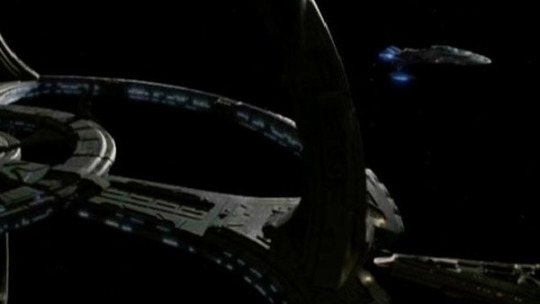
The finalized Mk1 design would enter service in late 2374, a far more conventional looking vessel, with all future class members being built to this design. Following the end of the Dominion war in 2375, the surviving Mk 0 hulls would receive ‘refits’ replacing their engineering hulls with the finalized Mk1 design. The final MK 0 Yeager (the prototype herself) would be refit in 2377.
4 notes
·
View notes
Text
Alternatives Have To Actually function The Same Way As The thing You Want To Replace
In order to suggest accurate alternatives, you have to first actually know what an items correct and full use is in the method it's being used. Suggesting an alternative that has no similar usage is not actually going to solve the problem and is frequently going to actually cause more problems than the one you're attempting to solve.
For example: Peat's use in gardening is as a moisture, weight, and aeration agent; it retains up to 20 times its weight in moisture, which keeps soil moist longer, while also providing lightness to the soil which allows for better, easier root development and aeration. This makes it ideal for use in potting containers and for seed starting.
Compost, however, is a building and fertilizing agent. It does not retain water itself, does not lighten soil load itself, and does not increase aeration itself- though these can be slight byproducts under specific circumstances (such as in adding it to certain inground soils like clay soil). But it does generally help to improve poor soil by adding nutrition and overall increasing positive environmental factors (such as bacteria, etc).
You cannot, say, substitute Compost for Peat if your concern is the ecological destruction wrought by Peat harvesting. They have two completely separate functions that are not actually comparable ... You have to actually find a product that performs the same functions as Peat*- which Compost actively does not do.
The answer for people looking for a legitimate alternative, by the by, is typically Coconut Coir / Coconut Hull, followed by Rice Hull, and, if you absolutely must, then small fiber Wood Mulch. None of these, however, are without their own various ecological and other concerns. Especially as demand for these kinds of alternatives continues to increase.
This is an opinion piece as a currently active Master Gardener, and is based directly in Research, Training, and Experience. If you found this helpful or interesting, please consider Tipping or Leaving a Ko-Fi (being Disabled, even $1 helps); you can see my other "Original Content" here.
#Original Content#Master Gardener#Master Gardeners#Gardening#2023#Oklahoma#Verderer#Green Witch#Green Witchcraft#Witchy Gardening#Witches Garden#Witch's Garden#Original Herbal Content#Gardenblr#Plantblr
4 notes
·
View notes
Note
Has there ever been a Christine actress where their acting far outshines their singing? Meaning, their singing is just ok, could be better, but where they lack in their singing they really act so wonderfully. There's also been some Christines with amazing voices, but then their acting needs some work. Not all can do both perfectly.
Yeah, a fair few; in fact, some of my favorites are Christines whose acting more than made up for their singing (same for Phantoms). Some examples of Christines whose acting outshone their singing:
Julie Hanson - Julie Hanson had that really generic Broadway Christine voice, you know, lots of vibrato and kind of a heavier voice, with a tendency to go flat on notes. But she was so incredibly good at acting like a traumatized, child-like Christine and worked very well with Hugh Panaro's Phantom.
Gina Beck - I think most everybody knows this one, but yeah, Gina Beck had a sweet voice but was amazingly inconsistent with it, sometimes sounding amazing and other times getting too shouty, or wobbly, or what-have you. But her acting was so good and she had clearly put so much thought into every movement and expression that you forgave everything.
Anna O'Byrne - I never grew used to Anna O'Byrne's voice, which always sounded weak and right on the verge of straining. But she had one of the most unique, Leroux-accurate portrayals ever.
Samantha Hill - Somewhat similar to Julie Hanson, her vocals were mediocre and she struggled noticeably with some high notes. But like Hanson (and also Gina Beck) there was so much energy and thought put into her acting that it didn't matter.
Lisa-Anne Wood - Lisa-Anne Wood has almost what I call the archetypal London voice of the last few decades: squeaky, light, more pop than classical. But her acting was so good and her chemistry with her Phantoms was amazing.
Ali Ewoldt - I never could get used to, or like, Ali Ewoldt's incredibly vibrato-heavy and rather harsh voice, and at first I found her acting decent but not too memorable. But by the end, she had improved so much, and her Christine was both energetic but with a strong backbone, and so emotional and passionate.
Holly-Anne Hull - Between Lucy St Louis and Anouk van Laake's beautifully classical vocals, Holly-Anne Hull is in a bit of a rough spot; she's definitely more "musical theater" in her sound. But as I've constantly said, her portrayal makes up for it - while her interpretation is fairly conventional, she's clearly thinking out every move, everything is consistent with her character, and she's pouring her heart and soul into it, every performance.
There's also plenty on the opposite end (vocals who out-shone their acting), so much more IMO that I won't list them, though a few that come to mind include Dale Kristien (strong vocals and the most amazing 'Think of Me' cadenza, dull acting), Claire Louise Hammacott (gorgeous operatic voice, the most boring portrayal I have ever heard), Claire Lyon (beautiful classical vocals, pretty conventional acting especially compared to some of her alternates e.g. Kristi Holden or Emilie Lynn), Elena Bahtiyarova (clear, pure voice, no change in facial expressions), Maria Ivleva (classical voice, no growth in her Christine whatsoever), Amy Manford (one of the most beautiful voices I've heard on London for some time, but acting and interpretation was more by the book, especially compared to Kelly Mathieson), and Anouk van Laake (another lovely voice, interesting interpretation that's a little lacking in execution).
23 notes
·
View notes
Text
Pile — All Fiction (Exploding in Sound)

All Fiction by Pile
Rick Maguire was ready. Pile’s frontman had been punting on the idea that the group’s “traditional rock band” setup of two guitars, bass, drums and a single vocalist needed reexamination since the aftermath of Dripping — whether it was studio time for a record or burnishing their reputation as your favorite band’s favorite band on tour, something was always in the way of a fundamental rethink to their sound. With Green and Gray firmly behind them, the departure of second guitarist Chappy Hull and a pandemic lockdown, there could be no more excuses. It was time to see what was left in the tank.
Speedy Ortiz’s Sadie Dupuis writes in the press bio of All Fiction that Maguire was heavily influenced by Mt. Eerie’s unusual timbres, Kate Bush’s ambition and Aphex Twin’s production. Broadcast, Krzysztof Penderecki, Portishead and Tinariwen are invoked as reference points. He says he was tired of the band’s identity, that he’d switched from a guitar to using synthesizers as his main instrument for composition, that lyrical directness took a backseat to more abstract forms of word association, that he “wanted to use different instruments and recording techniques to highlight the songs rather than creating the visual of a band performing them.” To hear Pile tell it, All Fiction is the band’s Kid A, a decadently grand break from the past.
This is an overstatement. In the same way that some people only know how to be who they are regardless of what they go through, Pile’s reinvention is by a matter of degrees, a slow-burning battle of inches. Perhaps more than anything, what All Fiction makes clear is that every new Pile record is the most like themselves they could possibly sound; it is the most Pile listeners have ever heard the band be.
Don’t read that in a negative light, though. Lessons learned both from the full-on improv jam sessions that comprised In the Corners of a Sphere-Filled Room and Maguire’s pandemic pet project of solo reworkings of old material, Songs Known Together, Alone, have fed directly into two fistfuls of songs that are at once as tight and as expansive as the band has ever been. The trio isn’t unrecognizable in their compositions, but it’s the way they use space that appears to have shifted. The result is formidable for fans and an easy entry point for those just joining the journey.
“Loops” was a logical first single, but its prominent, unusually polished percussion suggested this was going to be a much heavier record sonically than it is. More indicative is the last half-minute’s reverb-heavy solo guitar outro, which I said upon its release hints at a whole other song, a whole other world. That whole other world, as it turns out, is the record writ large: Though longtime acolytes will appreciate there are grimy guitar tones on “Gardening Hours” and a dour downtuning on, say, “Link Arms,” Maguire himself shoulders the weight of topics including the subjectivity of perception (it’s right there in the title, after all), big tech, the nature of making art, and the usual human concerns of anxiety and death while the music follows fleet-footed behind his instantly recognizable, miasmatic delivery punctuated by unshakable epigrams and notes that slide in and out of language.
For years, my biggest complaint about this band was how almost good they were at sequencing to the point that I thought they were doing it intentionally; think of how jarring A Hairshirt of Purpose’s segue from “Hairshirt” to “I Don’t Want to Do This Anymore” is, or the jam tacked onto “Appendicitis” in what otherwise would’ve been a perfect album closer for You’re Better Than This. That kind of maddening internal logic was part of their smirking low-stakes charm and a quirk you could (and I did) come to love. But something happened with Green and Gray in which they fully, finally worked out that the “rock” parts could commingle with the quieter, more introspective moments in a more fluid fashion, often in the same song. What resulted was 2019’s best album.
All Fiction furthers that thinking, another reason this feels less like a leap and more like a carefully considered step toward further Piledom — the band’s flowing, peripatetic nature makes writing about individual songs less important than considering the whole. It’s easy to catch yourself relistening to “Nude With a Suitcase” to see if there’s a bassline leitmotif from “Gardening Hours” (or some other record, not for the first time with this band) or wondering how the nearly five-minute “Blood” passes by percussionless at the same emotional tenor as the rest or considering how smartly the string quartet is deployed as a through-line from “It Comes Closer” right down to the final swell of “Neon Gray.” It wouldn’t be Pile without a transition like the one from “Forgetting” to “Poisons,” but even that still manages to work in context; if such things bother you, too, you’ll find yourself forgetting it’s there on repeat listens.
All of this writes around what All Fiction distilled to, which is what Pile has always distilled to: a guy wrestling with life’s antagonistic forces, trying to make sense of a world that doesn’t easily offer up proof of any. Green and Gray was an apotheosis of that, a resigned sigh backing reluctantly out of youth. All Fiction does the same, mostly with topics larger than relationships, but it’s still those unadorned drippings scattered across an increasingly surreal lyrical landscape that hit home hardest. On “Neon Gray,” Maguire laments, “Digging at nothing without romance / It’s just mist, but not from this distance / It’ll work until it won’t, I guess.” The beauty of this delivery can’t be overstated as the album’s last clearly sung words before the strings surge and his final chorus carries you out. Like any great Pile song (or any art worth a damn, really), it lodges in your throat, chokes you up, gets you thinking — and if what you’re thinking after a listen through All Fiction is that Pile is still your favorite band’s favorite band, it’s past time you found a new favorite band.
Patrick Masterson
5 notes
·
View notes
Text
Prompt #6: Small Burdens
Prompt 6: Onerous - FFXIV Write 2022
Characters: The Mammets of Seraphim’s Rest, Talia (kinda)
Each of them was, by design, meant to carry out some arduous task for the Master of the Workshop. This one carried materials, and that one worked on construction. Those over there crawled over submarine hulls and bows, ascended and descended airship rigging, worked in the bowels of machines that belched fire and groaned as if alive.
Theirs were the tasks best suited for small hands, and each of them performed their tasks to perfection, under the exact parameters they were designed for. But more and more, one or two of them would falter in their tasks. Once, this had meant being decommissioned, exchanged for another mammet, or being taken back into a workshop, perhaps never to be seen again..
But the Master of the Workshop had long since ceased complaining about the things they were deficient in. Instead, clever hands worked to give them improvements. Better quality limbs, more complex digits, sturdier chassis. Brains that could function and reason and rationale out why a certain course of action would be the most beneficial.
One by one, each of the mammets was given these upgrades, helped along by research from the one the Master called V. Where they had been uniform before, each of them had unique colors and markings now, outfits meant to mark them all apart. For ease of recognition, the Master insisted.
And when one of them broke down, they were no longer treated like a burden, but instead greeted like a friend in need of a break, their bodies too tired, their minds too stressed to work. From designations, to names. From numbers, to identity.
Tiny friends, the Master now called them. And care for them was, Talia found, no burden at all.
11 notes
·
View notes
Text
if you get the chance you need to see holly anne hull as christine, and if you saw her at the start of her run then see her again cause the improvement is insane. her wishing is genuinely one of the best musical theatre performances i’ve seen in a long time!
#lucy is fine but I feel she’s gotten a bit bored these past few months#anouk has a lovely voice but her acting is quite literally non existent lol#but holly is just SO good acting wise
7 notes
·
View notes
Text
How To Keep Pillow Cool?

It may seem odd, but keeping your pillow cold can help you get a better night's sleep. Fortunately, there are numerous options available. This article discusses the significance of keeping your pillow cold, as well as seven methods for doing so.
Why Maintaining a Cool Pillow Is Essential Prior to discussing how to maintain a cool pillow, it is essential to comprehend why you should. A cold pillow offers several advantages that can improve the quality and comfort of your sleep. The advantages of snoozing on a cool pillow include:
A cool pillow can help to relax the body, making it simpler to fall asleep, particularly during the hot summer months.
People suffering from insomnia can benefit from dozing on a cool pillow. A cool pillow can help regulate hormone imbalances and soothe the body, resulting in a more restful night's sleep.
Better sleep has been associated with greater mental health benefits. A soothing pillow can help you get a better night's sleep, resulting in more relaxed mornings.
Sleep deprivation can result in metabolic diseases such as diabetes, heart disease, and stroke. As a result of a more restorative night's sleep, the metabolism and body weight are healthier.
The 7 Best Methods to Keep Your Pillow Cool
Cooling Pillows or Pads: One of the best methods to keep your pillow cool is to sleep on a cooling pillow. These pillows use a variety of temperature-regulating technologies, such as active thermal regulation, which matches your body temperature as you slumber.
Pillowcases are available in a variety of sizes and materials, with some designed to diffuse heat. Some pillows use NASA-developed high-tech materials, while others use beads to absorb heat and keep the pillow cold and comfortable.
Placing cooling gel packs inside pillows is an effective method for keeping them cold throughout the night. These packs are available in a variety of sizes and can maintain their coolness for hours, ensuring that both sides of the pillow remain cold.
Bedside Fans Bedside fans can serve as an alternative to cooling gel packets, particularly when paired with ceiling fans. By placing a tray of ice in front of the fan, cold air can be directed toward the head and pillow.
Traditional Japanese buckwheat pillows, known as Sobakawa, are an additional option for keeping your pillow chilly. Buckwheat hulls generate tens of thousands of air pockets that increase ventilation, keeping your head and pillow cool.
Flip the Pillow: Flipping the pillow on its cool side can provide a rapid fix for a hot pillow, although the effect is temporary.
Maintain a Cool Room: Maintaining a cool room is essential for keeping your pillow and body comfortable. Using air conditioning, a fan, or an open window to regulate the temperature is possible.
Conclusion These seven techniques for keeping your pillow cold have all been tried and tested. Make sure you get more than six hours of sleep each night if you want to maintain peak performance the following day. Whether you suffer from insomnia or simply want a better night's rest, these techniques can help.
Main Post Link -
#CoolPillow#SleepComfortably#SummerSleep#SleepBetter#StayCool#GoodNightSleep#InsomniaRelief#MentalHealthAwareness#HealthySleep#PillowInnovations#SleepTips#StayCoolDuringSummer#SleepWell#BeatTheHeat#BuckwheatPillows#PillowCoolingMethods
2 notes
·
View notes
Text
Aluminium Alloy 6082 Sheets & Plates Exporters
Aluminium Alloy 6082 is renowned for its excellent combination of strength, corrosion resistance, and machinability, making it a highly sought-after material in various industries. Siddhgiri Tubes, a leading supplier in the market, offers high-quality Aluminium Alloy 6082 sheets and plates that cater to a wide array of applications. In this blog, we'll delve into the features, benefits, and applications of Aluminium Alloy 6082, highlighting why it's a preferred choice for many engineering and construction projects.

What is Aluminium Alloy 6082?
Aluminium Alloy 6082 belongs to the 6000 series of aluminum alloys, which are known for their magnesium and silicon content. This particular alloy is often referred to as a structural alloy due to its high strength and excellent mechanical properties. It is also one of the most versatile alloys available, making it suitable for a broad range of uses.
Key Features of Aluminium Alloy 6082
1. High Strength: One of the standout features of Aluminium Alloy 6082 is its high strength-to-weight ratio. This makes it ideal for applications where strong yet lightweight materials are required.
2. Corrosion Resistance: This alloy offers excellent resistance to corrosion, which is essential for applications exposed to harsh environments or corrosive substances.
3. Good Machinability: Aluminium Alloy 6082 is known for its ease of machining. It can be easily cut, shaped, and finished, making it a favorite among manufacturers.
4. Excellent Weldability: The alloy can be welded using various techniques, making it suitable for construction and fabrication projects.
5. Good Anodizing Response: It responds well to anodizing, allowing for improved surface properties and aesthetic finishes.
Applications of Aluminium Alloy 6082 Sheets & Plates
Thanks to its versatile properties, Aluminium Alloy 6082 sheets and plates find applications in numerous sectors:
1. Construction: Due to its strength and durability, Aluminium Alloy 6082 is widely used in construction projects. It is used in the fabrication of bridges, cranes, roof structures, and other structural components.
2. Automotive Industry: The alloy's high strength-to-weight ratio makes it ideal for manufacturing various automotive components, including frames, panels, and engine parts.
3. Marine Industry: Its excellent resistance to corrosion makes Aluminium Alloy 6082 suitable for marine environments. It is used in the construction of boat hulls, gangways, and other marine equipment.
4. Aerospace: The lightweight nature of Aluminium Alloy 6082, coupled with its high strength, makes it perfect for aerospace applications. It is used in the manufacture of aircraft structures and components.
5. Machinery and Equipment: Its machinability and durability make this alloy suitable for producing machinery parts and industrial equipment.
6. Railway: The alloy is also used in the railway industry for manufacturing components like train carriages and railway tracks, where strength and resistance to wear are crucial.
Why Choose Siddhgiri Tubes for Aluminium Alloy 6082 Sheets & Plates?
Siddhgiri Tubes is a trusted name in the supply of Aluminium Alloy 6082 sheets and plates. Here are some reasons why they stand out:
1. Quality Assurance: Siddhgiri Tubes ensures that all their products meet stringent quality standards. Their Aluminium Alloy 6082 sheets and plates are certified and tested to ensure optimal performance.
2. Customization: They offer customization options to meet specific client requirements. Whether you need particular dimensions or surface finishes, Siddhgiri Tubes can cater to your needs.
3. Competitive Pricing: They provide high-quality materials at competitive prices, ensuring value for money.
4. Expertise and Support: With years of experience in the industry, Siddhgiri Tubes offers expert advice and support to help you choose the right materials for your projects.
Conclusion
Aluminium Alloy 6082 sheets and plates are a versatile and reliable choice for various applications across multiple industries. Their unique combination of high strength, corrosion resistance, and machinability makes them indispensable in construction, automotive, marine, aerospace, and more. Siddhgiri Tubes, with their commitment to quality and customer satisfaction, is your go-to supplier for Aluminium Alloy 6082 products. Choose Siddhgiri Tubes for all your alloy needs and experience unparalleled service and quality.
0 notes
Text

Indian Navy officially receives aircraft carrier "Vikrant"
Diego Alves By Diego Alves 08/04/2022 - 15:00 in Military, War Zones
The Indian Navy made history by receiving the "prestigious" Aircraft Carrier (IAC) 'Vikrant' from its builder Cochin Shipyard Limited (CSL), Kochi.
Designed by the Directorate of Naval Design (DND) of the Indian Navy and built by CSL, a Public Sector Shipyard under the Ministry of Navigation (MoS), the aircraft carrier was named after its illustrious predecessor, India's first aircraft carrier to play a vital role in the 1971 war. Coinciding with the celebrations to commemorate the 75th anniversary of India's independence 'Azadi Ka Amrit Mahotsav', the reincarnation of Vikrant is a true testimony to the country's zeal and fervor in the search for capacity to increase maritime safety.
The 262-meter-long aircraft carrier has a total displacement of about 45,000 tons, much larger and more advanced than its predecessor. The ship is powered by four gas turbines totaling 88 MW of power and has a maximum speed of 28 knots. Built at a total cost of about Rs. 20,000 Crs (US$252MI), the project progressed in three phases of a contract between MoD and CSL, concluded in May 2007, December 2014 and October 2019, respectively. The ship's keel was "beated" in February 2009, followed by launch in August 2013. With about 76% of local technology, Vikrant is a perfect example of the country's search for "Aatma Nirbhar Bharat" and provides a boost to the Indian government's 'Make in India'.

The Vikrant aircraft carrier leaves Cochin Shipyard in Kochi, India, after its launch on August 12, 2013. Reuters Photo
The Vikrant was built with a high degree of automation for machine operation, navigation and survivability, and is designed to accommodate a variety of fixed-wing and rotary aircraft. The ship is capable of operating an air wing composed of 30 aircraft composed of MIG-29K fighters, Kamov-31, MH-60R multifunction helicopters, as well as advanced light helicopters (ALH) and domestically manufactured light combat aircraft. Using a new mode of operation for aircraft launch known as STOBAR (Short Take-Off but Arrested Landing), the IAC is equipped with a "ramp" for launching aircraft and a set of 'retention cables' for their recovery on board.
The ship has a large number of locally manufactured equipment and machines, involving the main industrial companies in the country. The efforts also led to the development of auxiliary industries, as well as the generation of employment opportunities and reinforcement of the return effect on the economy.
Vikrant during the tests at sea in September 2021. Photo Cochin Shipyard Limited
A major offshoot of this is the development and production of treated steel, for use on warships through a partnership between the Navy, DRDO and the Steel Authority of India (SAIL), which allowed the country to become self-sufficient with respect to the steel used on the ship. Today all the warships that are being built in the country are being manufactured with 100% local steel.
Several design iterations, including the use of 3D Virtual Reality models and advanced engineering software, have been used by the Naval Design Directorate to shape the design of the aircraft carrier. CSL has also updated its shipbuilding infrastructure, as well as improving productivity skills during ship construction.

Photo of the delivery ceremony. Photo MoD India.
The delivery of Vikrant was marked by the signing of acceptance documents on behalf of the Indian Navy by the Designated Commander of Vikrant, representatives of the Naval Headquarters and the Warship Supervision Team (Kochi), and by the President and Administrative Director on behalf of Cochin Shipyard Ltd., in the presence of senior officers of the Indian Navy and Cochin Shipyard.
Vikrant was delivered to the Indian Navy by CSL after extensive user acceptance tests carried out between August 2, 2021 and July 20, 2022, during which the ship's performance, including hull, main propulsion, auxiliary equipment, aviation facilities, weapons and sensors, as well as the maintenance and maneuvering capabilities at sea, proved satisfactory according to the test protocols and system parameters.

Indian Navy service members with representatives of Cochin Shipyard on the flight deck of Vikrant. Indian Marine Photo.
The delivery of Vikrant is the culmination of a long phase of design, construction and testing, during which the Indian Navy and CSL had to overcome a multitude of unprecedented technical and logistical challenges, including the COVID-19 pandemic and the altered geopolitical scenario. The successful delivery of the Indian aircraft carrier, in addition to an important activity and a historic event, testifies to the dedicated efforts of a large number of stakeholders in the Indian Navy, shipyard, industry, OEMs and M SMEs for more than two decades.
The aircraft carrier will soon be commissioned into the Indian Navy as Indian Naval Ship (INS) Vikrant, which will strengthen India's position in the Indian Ocean Region (IOR) by consolidating the Indian Navy as a local and global leader.
Tags: INS VikrantIndian NavyWar Zones - India/Pakistan
Previous news
Russian military satellite seems to be chasing a new U.S. spy satellite
Diego Alves
Diego Alves
Related news
MILITARY
HAL signs contract with Honeywell for the supply of engines
08/02/2022 - 14:00
HELICOPTERS
India receives first Sikorsky MH-60 "R" helicopters
07/29/2022 - 14:00
AERONAUTICAL ACCIDENTS
Indiana Air Force MiG-21 accident
07/29/2022 - 09:07 AM
F/A-18 demonstrates compatibility of aircraft carriers with the requirements of the Indian Navy.
MILITARY
VIDEO: Boeing F/A-18 Super Hornet successfully concludes operational demonstrations in India
07/20/2022 - 6:40 PM
HELICOPTERS
HAL from India marks first version flight with advanced light helicopter wheels
06/30/2022 - 6:30 PM
MILITARY
Super Hornet conducts ski-jump launch tests in India
06/01/2022 - 12:00
HOME Main Page Editorials Information Events Collaborate SPECIALS Advertise About
Cavok Brasil - Digital Tchê Web Creation
Commercial
Executive
Helicopters
History
Military
Brazilian Air Force
Space
SPECIALS
Cavok Brasil - Digital Tchê Web Creation
4 notes
·
View notes